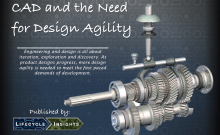Put simply, direct modelling is a CAD method that allows designers to interact directly with the geometry of the model. This means they can manipulate it by pushing, pulling, or twisting. So, unlike parametric modelling, where a features final geometry has to be built into the steps that create the final model, direct modelling allows the features geometry to be modified without having to edit the interim model stages.
The benefits of direct modelling?
Today, consumers demand more than just function from a product. They want products that look beautiful. In the past, creating the flowing, complex surfaces, which help people identify with a product, took a lot of time and effort.
To create this complex geometry, multiple sketch entities had to be linked together, to form and guide a surface along a desired path. But, with direct modelling, simple geometries now can be pushed, pulled, and twisted to create any shape imaginable. Because creating complex geometry is becoming much easier, its allowing design teams to quickly a greater range of designs for each product.
With the help of this new paradigm, design teams no longer have to settle for a design. They can now push the boundaries of what is possible and create more desirable products.
How does direct modelling works as part of your CAD system?
But, direct modeling isnt just about designing beautiful products that people want to buy. Direct modeling also gives you the power to modify previously created parametric designs without surrendering any of the models important dependencies. Because some CAD software now has the ability to take a parametric model and import it into a direct modeling environment. This means that making critical or dramatic design changes doesnt have to be an uphill battle.
This type of flexible modeling gives your design team the ability to preserve all of the hard built constraints and dependencies, while also leveraging the advantages of on the fly design modification. And, that can be critical when it comes to making late-stage design changes, using non-native files formats, or having to update older models where the design intent has been lost. All of this capability is available with the Creo Flexible Modeling Extension for Creo Parametric.
To find out more about agile design and the potential of direct modeling, download our free eBook today.


